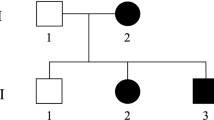Abstract
Hereditary spastic paraplegias (HSPs) are characterized by progressive spasticity in the lower limbs. They are clinically heterogeneous, and pure forms as well as complicated forms with other accompanying clinical findings are known. HSPs are also genetically heterogeneous. We performed clinical and genetic studies in a consanguineous family with five affected members. A genome scan using 405 microsatellite markers for eight members of the family identified candidate gene loci, and subsequent fine mapping in 16 members identified the gene locus responsible for the HSP. The clinical manifestations were very early onset spastic paraplegia (SPG) accompanied by mental retardation and ocular signs. The gene locus was identified as the interval 102.05–106.64 Mbp on chromosome 10. Gene MRPL43 was analyzed in the patients. No mutation but high levels of mRNA were detected. We have mapped a novel autosomal recessive complicated form of HSP (SPG45) to a 4.6-Mbp region at 10q24.3–q25.1 with multipoint logarithm of odds scores >4.5.




Similar content being viewed by others
References
Reid E (1997) Pure spastic paraplegia. J Med Genet 34:499–503. doi:10.1136/jmg.34.6.499
Hazan J, Fonknechten N, Mavel D et al (1999) Spastin, a new AAA protein, is altered in the most frequent form of autosomal dominant spastic paraplegia. Nat Genet 23:296–303. doi:10.1038/15472
Fonknechten N, Mavel D, Byrne P et al (2000) Spectrum of SPG4 mutations in autosomal dominant spastic paraplegia. Hum Mol Genet 9:637–644. doi:10.1093/hmg/9.4.637
Meijer IA, Hand CK, Cossette P, Figlewicz DA, Rouleau GA (2002) Spectrum of SPG4 mutations in a large collection of North American families with hereditary spastic paraplegia. Arch Neurol 59:281–286. doi:10.1001/archneur.59.2.281
Beetz C, Nygren AOH, Schickel J et al (2006) High frequency of partial SPAST deletions in autosomal dominant hereditary spastic paraplegia. Neurology 67:1926–1930. doi:10.1212/01.wnl.0000244413.49258.f5
Tsaousidou MK, Ouahchi K, Warner TT et al (2008) Sequence alterations within CYP7B1 implicate defective cholesterol homeostasis in motor-neuron degeneration. Am J Hum Genet 82:510–515. doi:10.1016/j.ajhg.2007.10.001
Casari G, De Fusco M, Ciarmatori S et al (1998) Spastic paraplegia and OXPHOS impairment caused by mutations in paraplegin, a nuclear-encoded mitochondrial metalloprotease. Cell 93:973–983. doi:10.1016/S0092-8674(00)81203-9
Stevanin G, Santorelli FM, Azzedine H et al (2007) Mutations in SPG11, encoding spatacsin, are a major cause of spastic paraplegia with thin corpus callosum. Nat Genet 39:366–372. doi:10.1038/ng1980
Patel H, Cross H, Proukakis C et al (2002) SPG20 is mutated in Troyer syndrome, a hereditary spastic paraplegia. Nat Genet 31:347–348
Hanein S, Martin E, Boukhris A et al (2008) Identification of the SPG15 gene, encoding spastizin, as a frequent cause of complicated autosomal-recessive spastic paraplegia, including kjellin syndrome. Am J Hum Genet 82(4):992–1002. doi:10.1016/j.ajhg.2008.03.004
Simpson MA, Cross H, Proukakis C et al (2003) Maspardin is mutated in Mast syndrome, a complicated form of hereditary spastic paraplegia associated with dementia. Am J Hum Genet 73:1147–1156. doi:10.1086/379522
Rainier S, Bui M, Mark E et al (2008) Neuropathy target esterase gene mutations cause motor neuron disease. Am J Hum Genet 82:780–785. doi:10.1016/j.ajhg.2007.12.018
Weber JL, Broman KW (2001) Genotyping for human whole-genome scans: past, present, and future. Adv Genet 42:77–96. doi:10.1016/S0065-2660(01)42016-5
Lindner TH, Hoffmann K (2005) easyLINKAGE: a PERL script for easy and automated two-/multi-point linkage analyses. Bioinformatics 21:405–407. doi:10.1093/bioinformatics/bti009
Meijer IA, Cossette P, Roussel J, Benard M, Toupin S, Rouleau GA (2004) A novel locus for pure recessive hereditary spastic paraplegia maps to 10q22.1–10q24.1. Ann Neurol 56:579–582. doi:10.1002/ana.20239
Mannan AU, Krawen P, Sauter SM et al (2006) ZFYVE27 (SPG33), a novel spastin-binding protein, is mutated in hereditary spastic paraplegia. Am J Hum Genet 79:351–357. doi:10.1086/504927
Seri M, Cusano R, Forabosco P et al (1999) Genetic mapping to 10q23.3–10q24.2, in a large Italian pedigree, of a new syndrome showing bilateral cataracts, gastroesophageal reflux, and spastic paraparesis with amyotrophy. Am J Hum Genet 64:586–593. doi:10.1086/302241
Elleuch N, Depienne C, Benomar A, Ouvrard Hernandez AM, Ferrer X, Fontaine B (2006) Mutation analysis of the paraplegin gene (SPG7) in patients with hereditary spastic paraplegia. Neurology 66:654–659. doi:10.1212/01.wnl.0000201185.91110.15
Paisan-Ruiz C, Dogu O, Yilmaz A, Houlden H, Singleton A (2008) SPG11 mutations are common in familial cases of complicated hereditary spastic paraplegia. Neurology 70:1384–1389. doi:10.1212/01.wnl.0000294327.66106.3d
Nolden M, Ehses S, Koppen M, Bernacchia A, Rugarli EI, Langer T (2005) The m-AAA protease defective in hereditary spastic paraplegia controls ribosome assembly in mitochondria. Cell 123:277–289. doi:10.1016/j.cell.2005.08.003
Ferreirinha F, Quattrini A, Priozzi M et al (2004) Axonal degeneration in paraplegin-deficient mice is associated with abnormal mitochondria and impairment of axonal transport. J Clin Invest 113:231–242
Acknowledgments
We thank the family for participating in the study, Dr. Piraye Serdaroglu for her contribution to the neurological evaluations, and Dr. Mustafa Atas for the ophthalmologic evaluations. We gratefully acknowledge the genome scan of the family performed by NHLBI Mammalian Genotyping Service (contract number HV48141). This work was supported by the Turkish State Planning Organization and the Scientific and Technological Research Council of Turkey (106T596). AT was partially supported by the Turkish Academy of Sciences. SAU was a fellow of the Scientific and Technological Research Council of Turkey.
Author information
Authors and Affiliations
Corresponding author
Additional information
Umut Dursun and Cigdem Koroglu contributed equally to this work.
Rights and permissions
About this article
Cite this article
Dursun, U., Koroglu, C., Kocasoy Orhan, E. et al. Autosomal recessive spastic paraplegia (SPG45) with mental retardation maps to 10q24.3–q25.1. Neurogenetics 10, 325–331 (2009). https://doi.org/10.1007/s10048-009-0191-3
Received:
Accepted:
Published:
Issue Date:
DOI: https://doi.org/10.1007/s10048-009-0191-3




